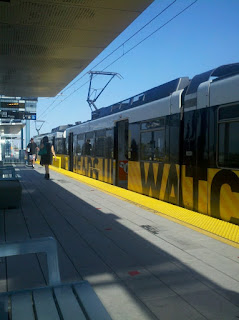If you live in an apartment and like listening to music louder than ambient sound, you need good headphones. Don't be that jerk who cranks up his tunes for the rest of the complex to hear. The bass in particular carries extremely well through the walls/floors/ceiling.
I just got a pair of Asus NC1 active noise cancelling headphones. I've never had active noise cancelling headphones before. I needed something to drown out talkative co-workers and I'm hoping these do the trick. I've heard Bose Quiet Comfort are the way to go for active noise cancelling, but my budget was less than a $100 (the Bose headphones are $300+).
We already had 2 nice sets of of headphones. The Sennheiser HD 280 Pro retails for just under $100 from multiple retailers (including Amazon). The Sennheiser HD 555 which retails for around $180, but you can find deals (they appear to be out of production based on scarcity and the radical range of prices). I also had a cheap, old pair of earbuds crammed in the bottom of my laptop bag.
 |
| clockwise from upper left: Asus NC1, Sennheiser HD 555, Sennheiser HD 280 Pro, generic earbuds |
Here's what I tested:
Midnight Special, CCR (digitally ripped from vinyl)
- Sennheiser HD 555: best bass and overall sound
- Asus NC1: good sound, vocals not as rich
- Sennheiser HD 280 Pro: "tinny" sound
- cheap earbuds: I'm sorry CCR, you were not meant to be heard like that
Have a Heart, Bonnie Raitt (digitally ripped from CD)
- Asus NC1: close tie with #2, but vocals really shined on this one
- Sennheiser HD 555: bass overwhelmed vocals throughout
- Sennheiser HD 280 Pro: still too "tinny"
- cheap earbuds: really not that bad if I wasn't comparing them
The She Coon of Women's Lib, Jerry Clower (digitally ripped from CD; storytelling for those not familiar)
- Sennheiser HD 280 Pro: close tie with #2, sounded like he was in the room
- Asus NC1: removed the "noise" from the recording (these are digitally remastered from old recordings so there are some slight pops and hisses, plus crowd noise)
- Sennheiser HD 555: sounded flat
- cheap earbuds: sounded like I was listening on AM radio
Rachmaninov's Piano Concerto #3, David Helfgott (digitally ripped from CD)
- Asus NC1: I listened the longest on them; satisfying sound and well-balanced; bass was occasionally "thumpy"
- Sennheiser HD 555: it felt like being in the front row of the concert hall; amazing surround sound type experience, but that was actually a little distracting
- cheap earbuds: sounded like classical music on the radio
- Sennheiser HD 280 Pro: piano sounded beautiful but drowned out the orchestra
Cream, Prince (CD on our stereo system)
- Asus NC1: AMAZING! I listened to the whole thing on these it was that good. I forgot how good this song was.
- Sennheiser HD 555: Pretty good, but paled in comparison to #1
- cheap earbuds: ok
- Sennheiser HD 280 Pro: terrible
I Shouldn't Even Be Doing This, Bob Newhart (audiobook CD on our stereo system)
- Sennheiser HD 280 Pro: Good voice clarity; pleasant listening
- the other three tied on this one; no distinguishing difference
What Is And What Should Never Be, Led Zeppelin (CD on our stereo system)
- Asus NC1: good sound, solid bass, clear vocals
- cheap earbuds: vocals suffered some, but instrumental parts were spot on
- Sennheiser HD 555: ok; very flat
- Sennheiser HD 280 Pro: blah
- After listening to this CD again, I realized this is a pretty poor digital recording. There are better digitizations than this out there. But then again, nothing sounds as good as quality vinyl on a good stereo system (short of live music). So far digital hasn't matched it for me. I wonder what happened to all my old records? I left them with my grandparents when we moved to Texas (they've long since passed away). I remember putting Puff the Magic Dragon in the big cabinet record player and sitting in the floor next to the speakers to listen.
Results: Asus NC1 was good for everything, but only with active noise cancelling turned on. I've heard that it is pretty standard for active noise cancelling headphones to need that function on at all times. The Sennheiser HD 555 is also good for general music listening. The Sennheiser HD 280 Pro is great for vocal only listening (audiobooks and most likely movies). The cheap headphones were $5, so they do about what you would expect for $5 and having been exposed to dirt, moisture, crushing weight, being wadded up, etc.
The Asus NC1 gets bonus points for being dainty and having a handy hard shell case that they fold flat into. Both Sennheisers are extremely bulky. However, the Asus cord is not as thick and seems a bit on the flimsy side for a $75 product. The Sennheiser cords are pro quality and have already stood up to a fair amount of use. The Asus is the lightest and most comfortable to wear. The Sennheiser 280 gives me a headache if I wear them very long at all and the Sennheiser 555 are comfortable enough for an hour or two, but I wouldn't want to wear them all day. Earbuds are obviously the lightest, but tend to slip out easily.
In terms of noise cancelling, only the Asus NC1 promises noise cancelling. For having small ear cups, they block out a surprising amount of ambient sound just by putting them on. With active noise cancelling on, traffic sounds, computer drone, and other noises disappear. I'm waiting to see how they do for people talking when I get them to work on Monday. The Sennheiser 280 blocks out low or distant noises, but lets in high noises and talking. The Sennheiser 555 are really no better than earbuds at blocking sound despite covering the ears entirely.













































